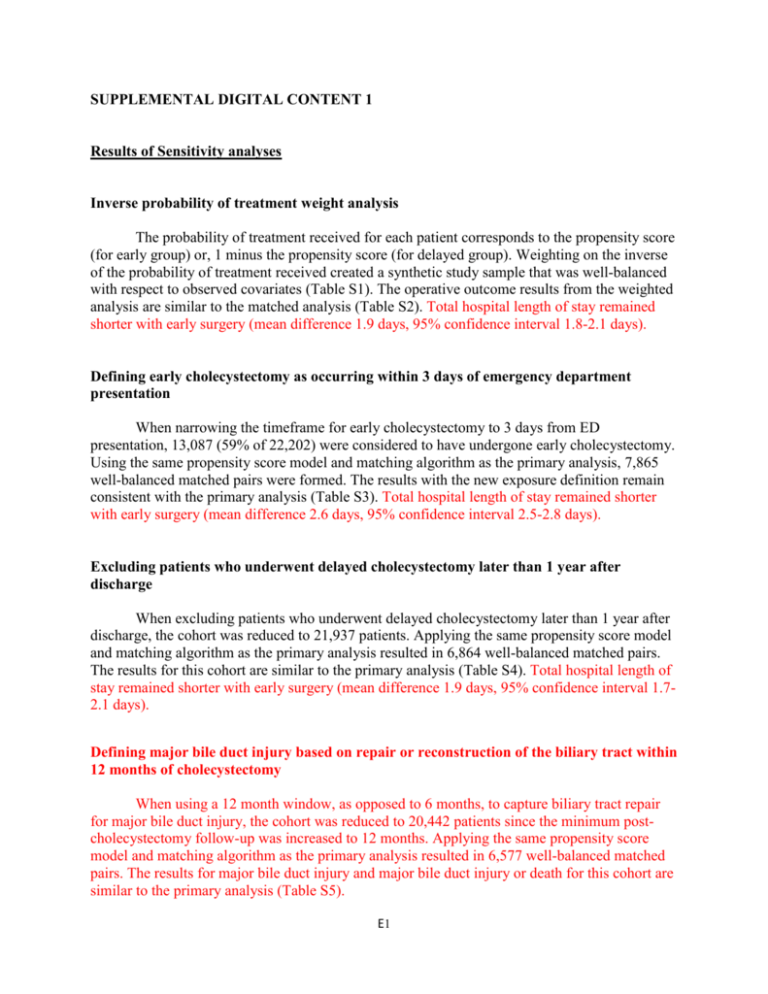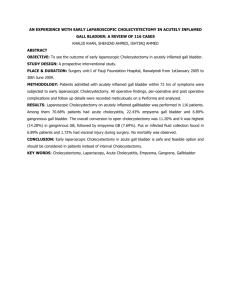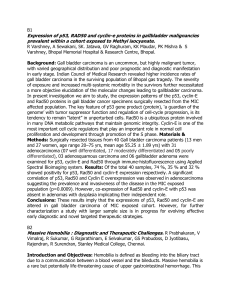SUPPLEMENTAL DIGITAL CONTENT 1 Results of Sensitivity
advertisement

SUPPLEMENTAL DIGITAL CONTENT 1 Results of Sensitivity analyses Inverse probability of treatment weight analysis The probability of treatment received for each patient corresponds to the propensity score (for early group) or, 1 minus the propensity score (for delayed group). Weighting on the inverse of the probability of treatment received created a synthetic study sample that was well-balanced with respect to observed covariates (Table S1). The operative outcome results from the weighted analysis are similar to the matched analysis (Table S2). Total hospital length of stay remained shorter with early surgery (mean difference 1.9 days, 95% confidence interval 1.8-2.1 days). Defining early cholecystectomy as occurring within 3 days of emergency department presentation When narrowing the timeframe for early cholecystectomy to 3 days from ED presentation, 13,087 (59% of 22,202) were considered to have undergone early cholecystectomy. Using the same propensity score model and matching algorithm as the primary analysis, 7,865 well-balanced matched pairs were formed. The results with the new exposure definition remain consistent with the primary analysis (Table S3). Total hospital length of stay remained shorter with early surgery (mean difference 2.6 days, 95% confidence interval 2.5-2.8 days). Excluding patients who underwent delayed cholecystectomy later than 1 year after discharge When excluding patients who underwent delayed cholecystectomy later than 1 year after discharge, the cohort was reduced to 21,937 patients. Applying the same propensity score model and matching algorithm as the primary analysis resulted in 6,864 well-balanced matched pairs. The results for this cohort are similar to the primary analysis (Table S4). Total hospital length of stay remained shorter with early surgery (mean difference 1.9 days, 95% confidence interval 1.72.1 days). Defining major bile duct injury based on repair or reconstruction of the biliary tract within 12 months of cholecystectomy When using a 12 month window, as opposed to 6 months, to capture biliary tract repair for major bile duct injury, the cohort was reduced to 20,442 patients since the minimum postcholecystectomy follow-up was increased to 12 months. Applying the same propensity score model and matching algorithm as the primary analysis resulted in 6,577 well-balanced matched pairs. The results for major bile duct injury and major bile duct injury or death for this cohort are similar to the primary analysis (Table S5). E1 Table S1. Baseline characteristics of patients and their surgeon in synthetic cohort after weighting on the inverse probability of treatment received Characteristic a Early cholecystectomy (n=14,948) Delayed cholecystectomy (n=7,254) 54 (21) 4,700 (31) 8,999 (60) 54 (31) 2,252 (31) 4,366 (60) 3,207 (21) 3,219 (22) 2,939 (20) 2,922 (20) 2,661 (18) 1,563 (22) 1,563 (22) 1,419 (20) 1,419 (20) 1,290 (18) 3.2±16.3 3,697 (25) 1522 (10) 709 (5) 3.2±23.3 1,772 (24) 736 (10) 344 (5) 21±12 3,731 (25) 21±17 1,711 (24) 72 (59) 3,661 (24) 72 (85) 1,841 (25) Patient Age, y mean (SD) ≥65 years, no. (%) Female sex, no. (%) Income Quintile, no. (%) 1 2 3 4 5b ADG c comorbidity index mean (SD) highest quartile, no. (%) Common bile duct obstruction, no. (%) Pancreatitis, no. (%) Surgeon Years since medical school graduation mean (SD) highest quartile (≥29) , no. (%) Number of cholecystectomies in preceding year mean (SD) highest quartile (≥90), no. (%) a All characteristics were well balanced (standardized differences of at most 3% as well as similar distributions of continuous variables when verified graphically). b Highest income level c Aggregated Diagnostic Group E2 Table S2. Relative risk of outcome after weighting on inverse probability of treatment Outcome a Relative risk b Major bile duct injury 0.56 (0.36 – 0.89) Major bile duct injury or death 0.71 (0.56 – 0.90) 30-day post-cholecystectomy mortality 0.67 (0.45 – 1.01) Cholecystectomy completed open 1.03 (0.98 – 1.08) Conversion among laparoscopic cases 0.99 (0.91 – 1.08) a Total study sample (n=22,202) included in analysis. Conversion was compared within the 21,936 laparoscopic cases b Relative risk (early compared to delayed cholecystectomy) is presented with the corresponding 95% confidence interval. Table S3. Relative risk of outcomes when defining early cholecystectomy as occurring within 3 days of emergency department presentation E3 Outcome a Relative risk b Major bile duct injury 0.48 (0.26 – 0.91) Major bile duct injury or death 0.57 (0.42 – 0.77) 30-day post-cholecystectomy mortality 0.61 (0.36 – 1.03) Cholecystectomy completed open 1.04 (0.96 – 1.13) Conversion among laparoscopic cases 0.93 (0.84 – 1.02) a The outcome results reflect 7,865 well-balanced matched pairs from a total study sample of 22,202. Conversion was compared within the 7,165 well-balanced matched pairs that began with a laparoscopic approach. b Relative risk (early compared to delayed cholecystectomy) is presented with the corresponding 95% confidence interval. Table S4. Relative risk of outcome when excluding delayed cholecystectomy later than 1 year after discharge Outcome a Relative risk b E4 Major bile duct injury 0.49 (0.28 – 0.84) Major bile duct injury or death 0.73 (0.56 – 0.96) 30-day post-cholecystectomy mortality 0.70 (0.45 – 1.11) Cholecystectomy completed open 1.07 (0.99 – 1.16) Conversion among laparoscopic cases 1.05 (0.95 – 1.16) a The outcome results reflect 6,864 well-balanced matched pairs from a starting sample of 21,937. Conversion was compared between the 6,242 well-balanced matched pairs that began with a laparoscopic approach. b Relative risk (early compared to delayed cholecystectomy) is presented with the corresponding 95% confidence interval. Table S5. Relative risk of outcome when capturing major bile duct injury as operative repair within 12 months of cholecystectomy Outcome a Relative risk b 0.42 (0.23 – 0.76) Major bile duct injury E5 0.70 (0.53 – 0.92) Major bile duct injury or death a The outcome results reflect 6,577 well-balanced matched pairs from a starting sample of 20,4421. b Relative risk (early compared to delayed cholecystectomy) is presented with the corresponding 95% confidence interval. E6









